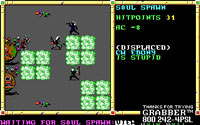History of MMO Games - Part I

We are starting a new series at DevilsMMO.com. The history of Massively Multiplayer Online (MMO) games. With its history of more than thirty years, MMO genre continues to be the most popular genre of online video games. But how did it all begin? Who came up with the idea of making an MMO? What was the first MMO? What made World of Warcraft so successful? Read it all in this History of MMO games articles...
History of MMO Games - Part I
The very beginning
Meridian 59 was launched in late-September 1996, published by 3DO and developed by Archetype Interactive. It had the honour of being considered the first fully 3D MMOGRPG, allowing hundreds of players to explore and kill monsters together. While that was the first example of the genre as we know it, the history of the MMO starts 20 years previously.

As early as 1974 people were playing Maze War – a multiplayer game that had you exploring a maze AND shooting people. I say people; they were actually little eyeballs that moved across the maze. Shooting was very much part of proceedings though, as attested by one of those who worked on the project,
Steve Colley: “Maze was popular at first but quickly became boring. Then someone had the idea to put people in the maze. To do this would take more than one Imlac, which at that time were not networked together. So we connected two Imlacs using the serial ports to transmit locations back and forth. This worked great, and soon the idea for shooting each other came along, and the first person shooter was born.”

The full history, written by Steve Colley, is available at Digibarn (http://www.digibarn.com/history/04-VCF7-MazeWar/stories/colley.html) and is well worth a read, it’s an important moment in gaming overall, and especially in multiplayer gaming.
Maze War would continue to be updated, ported and re-written well past its 30th birthday, where it continued to gain support from fans both old and new.
Others at the time were being influenced by single player games, things like Zork (and its port to programming language FORTRAN, Dungeon) and Adventure. From this background, MUD was born. MUD, standing for Multi-User Dungeon, would become the first internet-based multiplayer game in history and, in 1980, would consume countless students free time (and some of the time they were supposed to be working.)
Richard Bartle (http://www.mud.co.uk/richard/mudhist.htm), who worked with Roy Trubshaw on MUD, writes:
“The game was initially populated primarily by students at Essex, but as time wore on and we got more external lines to the DEC-10, outsiders joined in. Soon, the machine was swamped by games-players, but the University authorities were kind enough to allow people to log in from the outside solely to play MUD, so long as they did so between 2am and 6am in the morning (or 10pm to 10am weekends). Even at those hours, the game was always full to capacity. Thus, MUD became a popular pastime throughout the modem-using computer hobbyists of Britain. I also sent copies of the code to Norway, Sweden, Australia and the USA.”
MUD would continue to evolve and be copied for the next decade, with MUD being the defining word for the genre until the early nineties when MMOG started to be used.
So the seeds were certainly being planted, in Maze Wars you had an online world to explore and an enemy to destroy. Call of Duty fans would perhaps be underwhelmed by the lack of fire power, but the link to their favourite game is unmistakeable. Meanwhile, MUD had digitized the Dungeons and Dragons craze, allowing virtual adventure without the need to have people in your home.
MUD, like Maze Wars, is still available to play online, under the name “British Legends”.
If you’ve ever complained about a subscription fee, hold onto your hat. The first commercial MMO, Island of Kesmai, cost 2/3 cents every single command, with a 10 second delay for each command, a user could spend as much as $12 an hour in order to play.
Despite that fact, it was successful enough that it would continue to run, in various forms, until the year 2000. The game originally launched in 85, after 3 years of development.

In 1991 (until 1997), Neverwinter Nights was released for AOL customers. Like Island of Kesmai, players could spend hundreds, perhaps thousands of dollars a month thanks to the $6 an hour fee for playing. Again, despite the amazing cost, Neverwinter Nights was a hit. The server could originally hold 200 people (200 x 6 = $1200 an hour) but was rapidly expanded as the game became more popular.
As the internet evolved, so too did video games. While kids were being introduced to the likes of Sonic the Hedgehog and Super Mario, the online world continued to develop and attract fans in their thousands.
With the likes of Legends of Future Past paving the way for future games, the online gaming community was heading in a good direction. Legends of Future Past had paid Game Masters controlling events, allowing for users to become even more in-tune with the world. The virtual places they chose to explore began to evolve almost as quickly as the technology behind them and storylines became almost as important as the exploration.
In the case of Meridian 59, it narrowly beat other similar games to the punch. But, unlike earlier examples of the genre, Meridian didn’t prove financially acceptable to publisher 3DO.
Co-creator Andrew Kirmse writes:
“Chris and I had argued that we give the client away to as many people as possible, and then charge monthly fees. The standard $50 retail sale, on the other hand, allowed 3DO to recognize all of the revenue for the game immediately on shipment, which made their balance sheet for that quarter look healthier. When we proposed to do a larger follow-up game, we were turned down, and told to “fix” Meridian.
“However, we still didn’t have any additional staff beyond one new artist, so we designed a game update with incremental improvements, including additional areas and monsters. This was released as a free update called “Vale of Sorrows” in March, 1997. At this point, Chris and I had been working on Meridian for 3 years, and it looked unlikely that we would have the opportunity to do anything else at 3DO. The Wintergreen projects were cancelled and most of their staff were laid off. We left 3DO soon afterward.”
The genre had evolved to the point where it no longer could be handled like a regular game and, to reach a larger audience (as more and more people reached the internet) developers needed to find new ways to prove themselves.
As the PlayStation, N64 and PC proved that graphical power alone could sell games, the text-based MOD fell into an even deeper niche and the MMOG as it was soon looked incredibly outdated. Players needed something new, something bigger to keep them coming back and it came in the shape of Ultima Online.
Continue reading in Part II of The History of MMO games
Mat Growcott
© 2011 - DevilsMMO.com







Comments
Post new comment